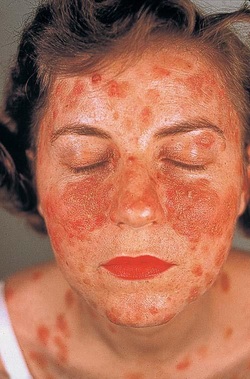Pemphigus: symptoms , causes , treatments
PEMPHIGUS
Pemphigus is a group of autoimmune skin conditions that cause sores , blisters or fluid filled bumps to form on your skin . these blisters can also form in your mucous membranes , which are the soft lining of your eyes , nose , mouth & throat .
The blister are soft and break open easily to form painful sores. they can spread over large areas of your body and have a risk of infection .
Pemphigus is sometimes confused with other autoimmune blistering skin conditions such as bullous pemphigoid , lupus erythematosus and Hailey - Hailey disease .
SYMPTOMS OF PEMPHIGUS
Symptoms vary based on the type of pemphigus you have but could include :
fluid filled bump or bubble on your skin [ blister ]
the skin around the blister is pink to red
sores that have a crusty appearance
blisters or sores leak clear fluid or bleed lightly
your skin around the blisters is fragile and peels in layer or scales .
pain on or near your affected skin
itchy skin
Severe symptoms of pemphigus include :
fever
fatigue
muscle weakness
vision problems and light sensitivity
CAUSES OF PEMPHIGUS
The causes of pemphigus is unknown . research that genetics and environmental factors play a role in your diagnosis.
Pemphigus is an autoimmune condition . this ,means that your body's defense system attack your body's healthy cells ,mistaking them for foreign invaders . when your body attack itself then the symptoms of pemphigus in the form of blisters or sores on your skin .
Rare cases it contains certain medication , including penicillin an antibiotic , piroxicam , a nonsteroidal anti - inflammatory drug used for rheumatoid arthritis , the blood pressure medication can cause the condition .
HOW IS PEMPHIGUS TREATED ?
Treatment is unique to each person diagnosed with pemphigus and could include :
- taking medicine to prevent infection and help your skin heal .
- stopping the use of medicines that causes your symptoms .
- wound care for blisters and sores.
Most people go through all three stages of treatments , which include :
- control high doses of medications control the spread of blisters nd begin healing existing ones.
- consolidation steady doses of medication continue healing blisters until most clear up .
- maintenance reduced levels of medication keep new blisters from forming .


Comments
Post a Comment